Fishwick P.A. (editor) Handbook of Dynamic System Modeling
Подождите немного. Документ загружается.


30-2 Handbook of Dynamic System Modeling
an individual belongs to, determining whether a certain class is a special case (subclass) of some other class,
and determining how two concepts are similar or different. Reasoners can be used for many purposes,
including checking for consistency and querying the ontology.
An ontology-based approach to simulation, in which a model is representedusing ontologyconcepts, can
help to address several problems with current methodology used to develop simulations within the domain
of agriculture and natural resources. The general goal is to better communicate knowledge about models,
model elements, and data sources among different modelers and between different computers. This is
achieved through the ontology’s ability to explicitly represent and thus define concepts used in models.
Various researchers create simulations within a particular domain to address a specific problem. There
is an overlap of the concepts and interactions used in these simulations. Frequently, different modelers use
different symbols for the same concept. The use of different programming languages makes communica-
tion even more difficult (Reitsma and Albrecht, 2005). Typically, a model is implemented in a particular
programming language like FORTRAN,C++, or Java. However, the meaning of the model is lost when it is
represented using program code (Furmento et al., 2001). Researchers must understand the programming
language to understand the model. While such models are usually documented using papers and manuals,
this documentation is physically separate from the model implementation itself. It is difficult to maintain
both the model and the documentation, and often the documentation is not an accurate description of the
model implementation. All the details of program code are difficult to describe in written documentation,
so that ultimately it is necessary to read computer code to truly understand how the model works. These
issues need to be addressed, so that the knowledge in a simulation can be made explicit (Lacy and Gerber,
2004; Cuske et al., 2005).
Typically, many different yet similar models are available for a particular domain. The challenge lies
in knowing precisely how two models are similar or different and selecting the one most suitable for
a particular task (Yang and Marquardt, 2003). When a particular model is encoded in a conventional
programming language, it is very difficult to do comparisons between models, and impossible to conduct
comparisons using automated techniques.
Most of the simulations in agriculture and natural resources use databases as a source of input data.
A simulation requires input data in a particular format, which is defined inside the simulation and which
is usually different from the format of the data stored in the database. The input data required for a
simulation must be matched with a database, and to do this matching, knowledge of the internals of
the simulation as well as the database is required. The matching is traditionally done manually, which
is certainly tedious if not error prone. There is a need for a technology that can represent and interpret
diverse data sources and support integration of these sources (Altman et al., 1999). The interoperability of
data can be solved by information integration (Miled et al., 2002; Altman et al., 1999).
Utilizing ontologies for managing model and simulation knowledge facilitates representing this knowl-
edge in an explicit manner. An ontology provides the model semantics that allows machines to interpret
concepts in an automated manner (Lacy and Gerber, 2004). The construction of ontologies encourages
the development of conceptually sound models, more effectively communicates these models, enhances
interoperability between different models, and increases the reusability and sharing of model components
(Reitsma and Albrecht, 2005). It also provides assistance in computation by structuring data (Altman
et al., 1999).
In this chapter, we discuss several important issues and problems addressed by ontology-based simula-
tion. We give an example of how to build a simulation using ontology techniques in a model of sequential
batch anaerobic composting (SEBAC). Tools for building ontology-based simulation are presented based
on a system we have developed that uses an ontology as a database management system.
30.2 Ways in Which Ontologies can be Applied to Simulation
The notion of combining ontologies with simulation has received much attention in recent years (Fishwick
and Miller, 2004; Lacy and Gerber, 2004; Miller et al., 2004; Raubal and Kuhn, 2004). This chapter
explores several different ways in which ontologies can be applied to simulation, and in particular how
Ontology-Based Simulation in Agriculture and Natural Resources 30-3
ontologies can solve some problems in current methods of building simulations for agriculture and natural
resources.
30.2.1 Model Base
Many physical processes in agriculture and natural resources are fundamental and well studied. For
example, basic crop physiology such as respiration and photosynthesis, soil/water dynamics, and crop–
pest interactions have been modeled extensively (Lu et al., 2004). Many different yet similar models
have been developed in each of these areas. One reason for the diversity of models is the diversity of
environments in which models need to be applied. There are hundreds of crops grown commercially, and
while as physical and biological systems they all share commonality, there is variability of climate and
geography as well as individualized crop characteristics that lead to differences in models. Furthermore,
each researcher describes a real-world problem based on different perspectives using his/her distinct
modeling environment (Park and Fishwick, 2005).
There are many crop models but there is no comprehensive management system for managing all these
models. Research is being done to develop a suite of crop models for a variety of crops and integrate these
with models for weeds and insects (Agriculture Research Service, 2005). Many other crops can be modeled
by assembling components from available models and changing parameters and rate equations. However,
having so many different yet similar models causes problems in managing models and in sharing model
components among developers. There is unnecessary redundancy resulting from poor communication
among developers. For example, there may be as many as two dozen irrigation models that all basically
operate on the principles of water balance. They may use similar ways of calculating processes such as
evapotranspiration, or they may use different equations to achieve the same results. Unfortunately, the
traditional methods for creating these models make it very difficult to compare the models to see how they
are similar or different.
An ontology can be used to build a database of models, that is, a “model base” that can help to classify
different but similar models and that can be searched to locate models and model components suitable
for some application. Each specific model can be represented by an instance in the ontology, and abstract
model structure and behaviors represented as classes. Similar models can be grouped together into a class,
and related classes grouped together to form superclasses. At the top of the resulting taxonomy would be
generic modeling approaches. If an ontology is also used to represent the internal structure of a model,
then model internals can be compared in an automated fashion to determine which parts of the models
are similar and which are different.
The vast collection of models and model components resulting from this analysis would create a large
but organized taxonomy. This taxonomy could be searched using query processors based on ontology
reasoners to locate models and model components of interest. It can also be used to compare and contrast
two models and explicitly identify how they are different or similar.
30.2.2 System Structure (Logical and Physical)
System structure can take many forms including a geometric structure, a chemical structure, or a phys-
iological structure. The use of object-oriented design for analysis of system structure is well known and
one of the first applications of object-oriented programming dating back to the 1960s. The biological and
physical systems in agriculture and natural resources are also analyzed in this fashion by decomposing
a complex system into simpler interconnected parts and subparts, and modular, object-oriented designs
are widely used (Beck et al., 2003; Kiker, 2001). Of course traditional object-oriented design uses pro-
gramming languages such as Java or C++ as a representation language. Using an ontology is the next
step in this approach (Fishwick and Miller, 2004). There are several advantages to elevating the objects
comprising the system to the status of ontology objects. For one, the model description and behavior is
forced to be done in an entirely declarative fashion. Ontologies do not utilize methods or program code
to represent behavior. Instead the representation is based entirely on concepts and relationships. Also,
by using ontology objects, model components can be classified and interrelated based on their meaning.
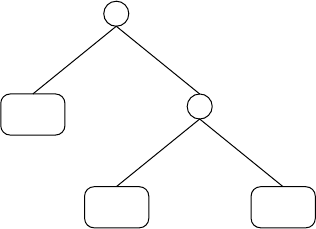
30-4 Handbook of Dynamic System Modeling
NH
4
+
NH
3
N
t
FIGURE 30.1 Representation of equation as a tree structure.
System structure is made explicit in a way that can be exploited by ontology reasoners to compare and
contrast model structures.
30.2.3 Representing Equations and Symbols
Model behavior can be described entirely using mathematical equations (Cuske et al., 2005). Equations
are composed of symbols, and each of these symbols can be represented as a concept in the ontology. This
enables the symbol’s meaning to be more exposed and accessible to analysis and manipulation. Whereas
equations describe the quantitative behavior of variables, the variables are also symbols, and the things
the symbols represent can be made explicit. Furthermore, the basic mathematical operators can also be
treated as symbols and described in the same fashion.
Equations can be stored in the ontology by representing them as tree structures. For example, the
formula
NH
+
4
= N
t
−NH
3
can be expressed using the tree structure in Figure 30.1. The tree is rooted on the equal symbol, and
equal has a left side and right side which are the first two branches in the tree. Operators, such as minus,
are nodes in the tree with subtrees for each of the operator arguments. Each node in the tree, including
operators and variables, become concepts in the ontology. Each concept includes associations to related
concepts, for example,“minus” contains associations to the concepts being subtracted.
The advantage of better defining symbols appearing in equations is improved interoperability of con-
cepts and associated symbols appearing in different models. In addition, with the inclusion of basic
operators, the ontology can classify groups of equations and organize them taxonomically from generic
forms to specific applications. This will lead to discovery of similarities in forms of equations used in
different models, and will help to communicate among different modelers (Altman et al., 1999).
There is one obvious limitation of using ontologies to store and organize equations. While an ontology
is a valuable tool for representing the meaning of the symbols, including operators, appearing in equations,
it has no facilities for solving equations or even performing simple arithmetic operations needed to do
simulation. Although, it is possible that an ontology could be extended to support analytical equation
solving, this area has not been explored and goes beyond the scope of ontology reasoners. Instead, whereas
the ontology acts as a library for organizing equations and their symbols, external facilities are needed
to solve the equations. An external code generator can take equation structures that are stored in the
ontology and automatically produces XML, or program code in C++ or Java (or other languages) that
can implement the simulation.
30.2.4 Connecting Models with Data Sources
Most simulations in agriculture and natural resources require access to data. Basic physical data, such
as weather data, soil parameters, and records of production operations including nutrient, pesticide,
and irrigation applications, are all stored in databases (Beck et al., 2004). These databases can come in
Ontology-Based Simulation in Agriculture and Natural Resources 30-5
many forms and are geographically distributed. Unfortunately, there are many and different databases
implemented on different database management systems.
There are several problems associated with attaching these data sources to the simulations that need the
data to run. These include logical considerations, such as determining if the database has the necessary data
in the correct form to provide the inputs required by the simulation. There is also a physical connection
problem as the software used for the simulation must be capable of attaching to the database and querying it
to extract the necessaryinformation. There are also issues of resolution,in time and space, such that the data
provided is on the same resolution or can be converted to the same resolution as that required by the model.
Establishing the logical and physical connection between a model and database can be a tedious process.
To establish this connection, a developer must become very familiar with both the model and database. The
input requirements for the model must be fully specified (this is typically done with text-based documents)
and understood, and likewise the database schema and the meaning of all the attributes available in the
database must be studied in detail. Then the person establishing the connection must match the model
inputs and the database attributes. Seldom is this a perfect match, and often the model requires inputs
that the database cannot provide. In this case, the database must be expanded to include the necessary
inputs or it cannot be used to drive the simulation. Creating the physical connection is also tedious, as
usually code in the form of SQL statements must be written to extract the information from the database
needed by the simulation. Depending on how the database is published, additional work may be needed
to connect the simulation software with the data source using technologies such as ODBC, RMI, or Web
services (Mills-Tettey et al., 2002).
It would be possible for a simulation to automatically search for and attach to a data source. This
would require having a sufficiently rich description, in the form of an ontology, of both the simulation
input symbols and the entities and attributes in the database. A particular input symbol in the simulation
could match automatically to a database attribute. This would be accomplished by matching the ontology
descriptions of the model symbol and the database attribute to prove that they are compatible. Databases
and models could be published on the Internet as a Web service (Knutson and Kreger, 2002). The Web
service registry could be queried to determine the contents of databases contained in the service. The
physical connection between the model and database would be automatic using XML as the method of
exchanging data.
30.2.5 Integrating Documentation and Training Resources
If the ontology is part of a complete database management system, the ontology can store and organize
any content, including multimedia content in the form of rich text, images, 2D/3D animations, and video.
In the context of simulation, this creates a complete environment for all information associated with the
simulation. In particular, all research materials (experimental procedures, raw data, statistical analysis,
technical reports, and journal articles) and educational resources (training-based simulations, scenario
training, and case studies) can be integrated.
30.2.6 Reasoning
The power of ontologies lies not only in their ability to provide declarative representations of concepts and
their relationships, but also in the ability to automatically reason about those concepts. Basic reasoning
facilities include ontology validation, automatically determining subsumption relationships (determining
if class A is a subclass of class B), and classification (automatically determining the location of a new class
within the class taxonomy). Extended facilities included automatic clustering (conceptual clustering) of
concepts, and analogical reasoning or similarity-based queries and case-based reasoning. These facilities
can be applied to simulation to automatically classify models, model components, and the equations and
symbols used in the models. Query facilities based on reasoning can help to locate simulation elements
within a large collection. Clustering techniques can compare the structure of two models and tell how they
are similar or different.
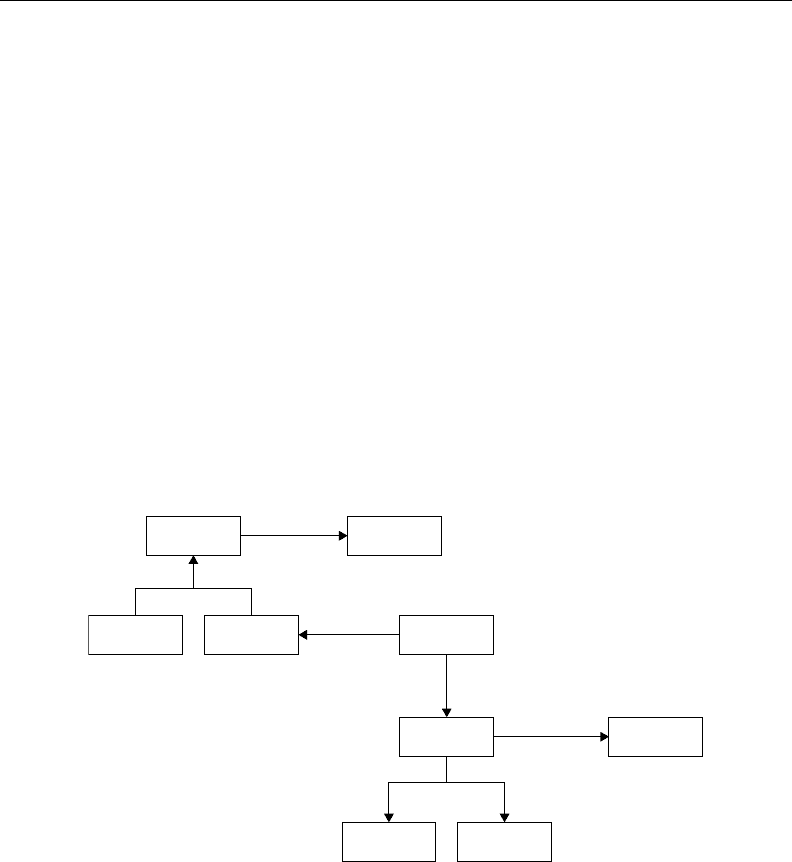
30-6 Handbook of Dynamic System Modeling
For example, the knowledge in an ontology in the bioprocessing domain can be used for automatically
generating equations based on physiochemical equilibrium laws. A particular law can be applied based
on the specific property of an individual. In the SEBAC simulation (Section 30.3) fatty acids dissociate
into fatty acid ions based on a physiochemical equilibrium law, and that law is represented by an equation
stored in the ontology. The reasoner can automatically instantiate an equation corresponding to the law
when it finds that an individual of the fatty acid class has a property called “in equilibrium with” and the
range of the property is fatty acid ion. It would use the particular properties of the individuals involved to
parameterize the equation.
30.3 How to Build an Ontology-Based Simulation—
Bioprocessing Example
SEBAC is an anaerobic digestion process that decomposes organic matter into methane and carbon dioxide
by a series of reactions in the presence of several microorganisms. It is used for treating the organic fraction
of municipal solid waste. A mathematical model of SEBAC has been developed to understand the SEBAC
system and to study the response of the system for various feed conditions (Annop et al., 2003). The model
consists of a set of differential equations, which have been constructed based on mass balance and physio-
chemical equilibrium relationships. The steps in building an ontology-based SEBAC model are as follows.
30.3.1 Collection of Relevant Documents
The first step in building an ontology-based simulation is to collect all relevant documents such as technical
papers of the system and any existing related models. In the case of SEBAC, an existing model had already
been implemented using MATLAB (Lai, 2001). We were able to obtain a graduate thesis describing the vari-
ables and equations used in the model (Lai, 2001), a research publication describing the implementation
of the mathematical model (Annop et al., 2003), and source code of the MATLAB implementation.
It would have been useful to have access to a conceptual model for understanding the conceptual
schema of the system. A simple conceptual model of the process was sketched for understanding the
SEBAC domain. Figure 30.2 shows a conceptual model with nine concepts (owl: Class) and three types
of interactions (owl: ObjectProperty). These classes have individuals that can be mapped to the variables
used in the simulation. There are six individuals of bacteria and six individuals of fatty acids in the SEBAC
system that are mapped to the state variables of the model.
Insoluble
substrate
Soluble
substrate
Substrate
Reactor
Bacteria
Fatty acid
Methane
Carbon
dioxide
Fatty acid
ion
Stored in
Acts on
Acts on
Converts to
Converts toConverts to
FIGURE 30.2 Conceptual model of SEBAC system.

Ontology-Based Simulation in Agriculture and Natural Resources 30-7
30.3.2 Define Model in Terms of Elements
The next step is to define the model in term of elements. Elements are used to modularize the model into
logical units. Related classes, individuals, properties, and equations are entered in a particular element.
The description of the model in terms of elements is helpful in understanding the structure of the model.
Typically, a modeler designsa particular model by creating a graph containing elements and links indicating
the information flow between elements. Our tools allow modeler to use a SimulationEditor (Section 30.4)
to build the module structure in the form of an element graph.
The SEBAC simulation involves biological process. The simulation is described in terms of elements that
capture the important processes like bioconversion of fatty acids and substrate and dissociation of fatty
acids. Figure 30.3 shows the elements of the SEBAC model and gives an overview of the SEBAC process
including various transformations that occur during the process.
30.3.3 Identifying Classes, Individuals, and Properties
After defining the general elements of the model, specific concepts in the model are identified. For the
SEBAC system, the concepts were identified from the list of variables used in the model (Lai, 2001). From
these, we created the following classes with the corresponding properties:
•
Reactor—liquid volume, gas head space, and reactor temperature
•
Fatty acid ion—equilibrium constant for dissociation and conversion factor
•
Fatty acid
•
Bacteria—biomass death rate, half velocity constant and maximum growth constant
•
Methane
•
Carbon dioxide
•
Soluble substrate and insoluble substrate
Calcium ion
Nitrogen content
Total propionic acid
S4
Propionate bacteria
Hydrogen content
determines
Converts to
Converts to
Converts to
Converts to
Acidogens X1
Total acetic acid S3
Converts to
Converts to
Converts to
Converts to
Converts to
Converts to
Converts to
Converts to
Substrate
Stored in
Dissociates to
Converts to
Hydrogen_aq
Insoluble substrate
S1
Methane_g
Hydrogen ion
Carbon dioxide
content
Acetoclastic
methane bacteria
Soluble substrate S2
Reactor1
Total butyric acids S5
Butyrate bacteria
FIGURE 30.3 SimulationEditor diagram for SEBAC process showing elements of SEBAC simulation and showing
various transformations that occur during the process.
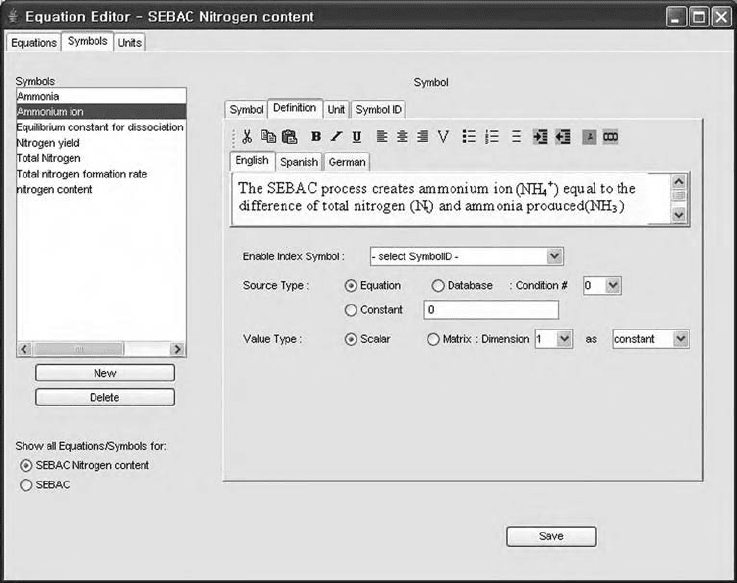
30-8 Handbook of Dynamic System Modeling
FIGURE 30.4 Interface of EquationEditor to input the concepts in a particular element of the simulation.
Some of these classes have several individuals. There are three individuals of fatty acid ion, and each fatty
acid ion has a specific value of equilibrium constant for dissociation and conversion factor. Relevant classes,
individuals, and properties are entered in a particular element. Figure 30.4 shows how an individual called
“Ammonium ion” is entered into the ontology database. The other classes, individuals and properties are
entered into the database in a similar fashion.
In conventional modeling languages, the meaning of the symbols and the relationships between the
symbols are not defined explicitly. The SEBAC model has symbols for various forms of nitrogen such as
ammonia, nitrate, and ammonium ion, but the simulation written in MATLAB does not explicitly specify
relationship between these forms of nitrogen or the meaning of each form. The meaning of the symbols
and relationships can be defined explicitly using an ontology. Figure 30.5 shows a portion of the ontology
for different forms of nitrogen.
In the SEBAC model, total dissolved nitrogen is found in the form of ammonia, which in turn can be
found in two forms: ammonium ion (NH
+
4
) or dissolved ammonia gas (NH
3
). In Figure 30.5, there is a
relationship called“consists of”with a domain of total dissolved nitrogen and a range of forms of ammonia
(NH
+
4
,NH
3
). Ammonium ion concentration is calculated by the difference of total dissolved nitrogen and
ammonia. NH
+
4
and NH
3
are in equilibrium and their concentration is given by the equation:
NH
+
4
NH
3
+H
+
Figure 30.5 contains a property called“in equilibrium with” having NH
+
4
as a domain and NH
3
as a range
that models reversible conversion between these two forms of ammonia. Ammonium ion and hydrogen
ion are specific kinds of ion, and thus are shown as subclasses of the class ion. Ammonia is defined as a
specific kind of gas, so it is also subclass of the class gas. There is a relationship called “converts to” between
NH
+
4
and NH
3
.
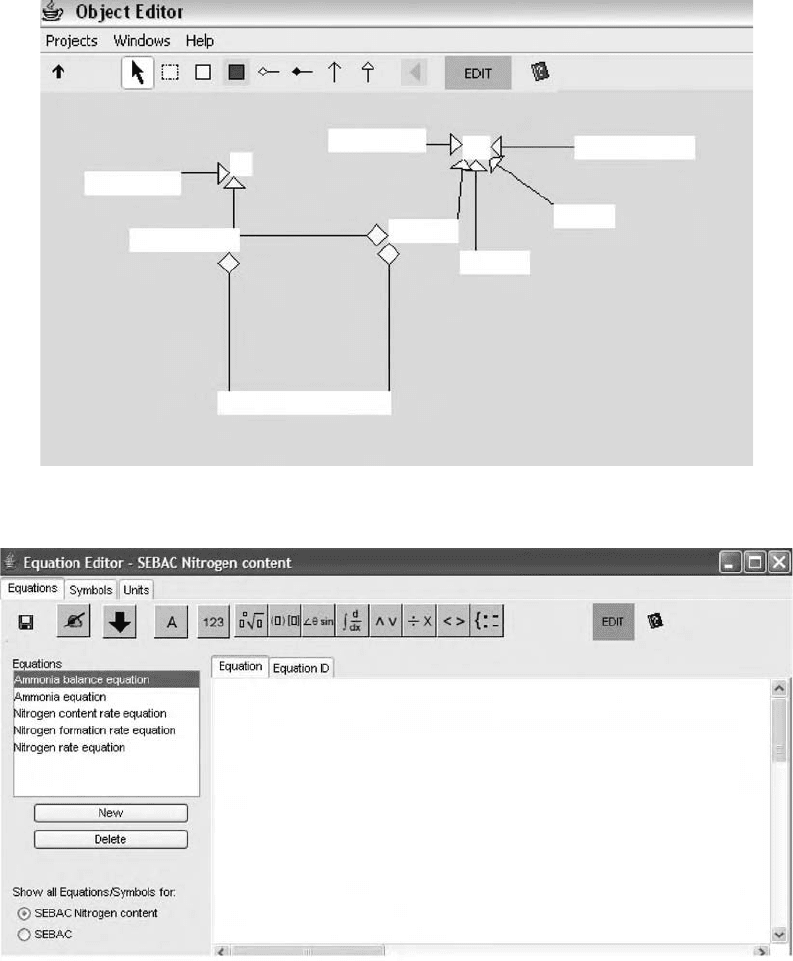
Ontology-Based Simulation in Agriculture and Natural Resources 30-9
Ion
Hydrogen ion
Ammonium ion
In equilibrium with
Consists of Consists of
Hydrogen
Ammonia
Nitrous Oxide
Gas
Nitrogen Dioxide
Nitrogen
Total dissolved nitrogen
FIGURE 30.5 Ontology for different forms of nitrogen.
NH
4
_plus Nt NH
3
FIGURE 30.6 Interface of the EquationEditor for entering equation.
30.3.4 Define Equations
The equations describing dynamic behavior are entered in the system after entering the classes, individuals,
and properties of symbols that are used in the equation. Figure 30.6 shows the EquationEditor for entering
an equation that represents the relationship between total dissolved nitrogen, ammonia, and ammonium
ion concentration.
An equation models the dynamic relationship between concepts (classes) and represents a statement of
a specific law. The Michaelis–Menten equation (Heidel and Maloney, 2000) models a relationship between

30-10 Handbook of Dynamic System Modeling
acid and bacteria. Acetic acid is an individual of the acid class and acetolistic methane bacteria is an
individual of the bacteria class. The acetolistic methane bacteria acts on acetic acid, and this relationship
can be modeled by Michaelis–Menten equation. These relationships can be explicitly shown in ontology
as properties. It is also possible to store the specific laws in the ontology based on the relationship between
classes so that the equations can be automatically generated based on the specific relationships between
individuals by using an ontology reasoner as described in Section 30.2.6.
30.3.5 Initial Values of State Variables, Constants, and Database Access
Initial values of state variables are entered manually using an input form which is generated automatically
based on the logic that each differential equation has a state variable and that an initial value is required
for each state variable. The SEBAC simulation has 21 state variables so the input form has 21 text fields.
The value of constants (like the universal gas constant) and other parameters used in the simulation are
entered as properties in individuals representing these constants as described in Section 30.3.3.
Many simulations obtain inputs from databases, such as weather databases or database of farm produc-
tion practices. The simulation can input values from the database by matching individuals representing
the inputs with individuals representing the database attributes as discussed in Section 30.2.4.
30.3.6 Generating Program Code for Implementing the Simulation
Program code for running the simulation is automatically generated by processing the descriptions of
model structure and behavior (equations) stored in the ontology. Currently, our system generates Java
code, but other languages can be supported. Code generation involves retrieving equations and symbols
belonging to each element in the ontology database and making a reference list of symbols having the
hierarchical structure of operators in each equation. A Java class is generated for each element of the
simulation (mainly to partition the code into logical modules). The symbols for variables belonging to
an element are generated as member variables in the Java class while the equations are generated as Java
methods. Each method returns a value for a particular variable based on an equation defined for that
variable. For example, a Java method is generated corresponding to the ammonia balance equation shown
in Figure 30.6 that returns the value of NH
+
4
.
30.3.7 Simulation Execution
After generating the Java code, the code is compiled and the simulation is executed. The simulation results
are presented in the form of charts and tables. To enhance interpretation, the results of the simulation
can also be presented as an animation. The dynamics of the SEBAC simulation is shown in terms of
reactors that change colors based on pH and other chemical properties of the system (Figure 30.7). The
ontology facilitates creating these animated interfaces by storing graphic objects that can be used to render
an animation along with the associated model concepts.
30.4 Tools for Ontology-Based Simulation
This section describes some new Web-based authoring tools that we have developed for facilitating con-
struction of ontology-based simulations. These tools are Java applets that can be accessed online using
standard Web browsers that have the Java plug-in installed. Wherever possible we designed these tools to
be visually similar to traditional tools such as equation editors and editors for building system component
diagrams. However, our tools utilize the ontology as the back-end for representingall conceptsin the model.
30.4.1 Ontology Editor
There exists a variety of ontology editors such as KAON, which is a popular ontology editor extending
RDFS (Volz et al., 2003), and (Knowledge Base Editor) (KBE), also known as Zeus and Protégé (Noy
et al., 2001). These editors have a rich set of features for building ontologies and support exporting their
ontology model to OWL. They include common functionalities and support several plug-in.
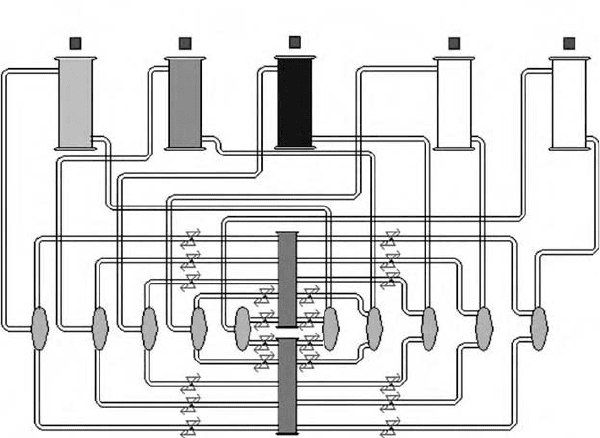
Ontology-Based Simulation in Agriculture and Natural Resources 30-11
fill fill fill fill fill
SEBAC simulation
FIGURE 30.7 Interface for presenting results of SEBAC simulation using animation.
Although they have excellent features, these tools can be difficult to use because they require high
level skills and understanding of ontologies and ontology modeling languages. These ontology editors are
general purpose tools and are not designed specifically for developing simulation models. To facilitate
developing ontologies for simulation, we created new editors which not only have more familiar graphic
interfaces, but also are based on the features of these traditional ontology editors as a back-end. They have a
dual-modality in which the modeler can either view the ontology-based simulation using traditional visual
modeling tools (Figure 30.6) or view the ontology concepts in a graph-based ontology editor (Figure 30.8).
For the classic ontology view, our ontology editor adopts the dynamic graph layout from TouchGraph
(TouchGraph Website, 2005) as illustrated in Figure 30.8. The editor includes tools for creating concepts
and describing properties. Two types of concepts are displayed in this editor: concepts representing the
symbols that appear in equations and concepts representing entire equations. The dynamic graph layout
integrates these two as one graphic view such as shown in the figure. Each node represents a symbol, and
the relation sign represents relationships between symbols in an equation.
30.4.2 EquationEditor
The process of building an equation starts with representing the equation as a mathematical expression of
symbols, including numbers and operators. The equation is rendered visually using classic mathematical
notation, but internally a hierarchical data structure (tree) is used for storing operators and symbols. Each
node in the equation tree is also a node in the ontology. For a particular equation, the equal operator is
the root node of the equation tree. Operators (like +and −) used in the equation become a node in the
tree with child nodes being additional operators or symbols.
The EquationEditor (Figure 30.4) includes a symbol dictionary for entering symbols appearing in the
equations along with their definitions and units. Each symbol is defined both using a gloss (this is a brief
definition in English) and by relationships to other symbols as expressed in the ontology. Equations can
automatically be converted to a sharable format, such as OpenMath or MathML, or to Java code using
code generators.
It is very important to carefully track the units associated with symbols. Different models may use the
same symbol but having different units. For example, mass per unit volume can be expressed with kg/m
3
